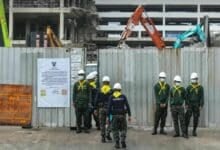UPDATE: Typhoon Rai – Rescuers battle to reach affected areas, 208 confirmed dead

At least 208 people have been killed as authorities and emergency workers start mopping up the mess left from the destructive path of Typhoon Rai (named as Odette in the Philippines). More than 400,000 people have also been displaced after the strongest typhoon to hit the Philippines in 2021 slammed into the central east coast last Thursday and cut a swathe of destruction as it travelled westward, causing widespread damage and flooding.
The typhoon’s death toll will climb further as search and rescue services continue to arrive at the worst affected areas after they were initially hampered by power and communication outages. Many of the serviceable boats that could reach the islands or evacuate people, were also damaged or wrecked in the peak of the storm.
“If it was like being in a washing machine before, this time there was like a huge monster that smashed itself everywhere, grabbed anything like trees and tin roofs and then hurled them everywhere.” -AP
The typhoon is now centred in the South China Sea, south of Hainan Island.
The epicentre of the first wave of destruction was Siargao Island, a popular tourist and surfing holiday destination on the central east coast. Winds of up to 260 kilometres per hour (160 mph) were recorded, equivalent to a Category 5 storm or hurricane.
“The wind was swirling north to south to east and west repeatedly for six hours. Some tin roof sheets were blown away then were tossed back.” -AP
Typhoon Rai ripped through homes, toppled trees and power poles, and dropped torrential rain as it plummeted through the central Philippines. About 75% of the houses, many of them ramshackle family homes, in Bohol province have been damaged or just blown away. 227 cities and municipalities across the central Philippines experienced power outages and more than 25 scheduled flights were cancelled with many others postponed or diverted.
As of this afternoon, 52 people remain missing, while officials have reported 239 others have suffered “considerable injuries”.
Arial surveillance reveals roads and fields flooded for kilometres in every direction after the torrential downpours in the wake of the fierce winds.
More than 700,000 people were heavily impacted by the super typhoon, including more than 400,000 people who had to be moved to emergency shelters and off the smaller islands.
Latest Thailand News
Follow The Thaiger on Google News:


























